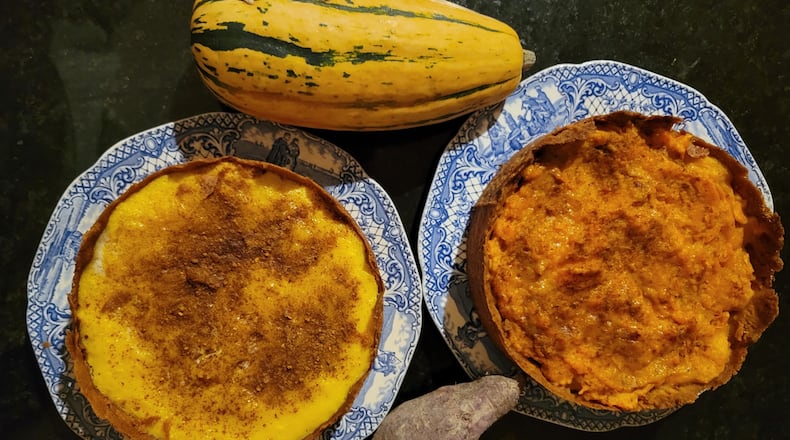A pie pumpkin makes a cute seasonal decoration, but I don’t recommend actually baking a pie with it. I tried a few years ago.
Two reasons for this caution. First, preparing a pumpkin for use in a pie is messy and time-consuming. The pumpkin must be cut, cleaned, and roasted before the flesh can be used in a pie. The effort isn’t worth it, because the resulting flavor of a true “pie” pumpkin pie is pallid.
Most pumpkin pie bakers reach for a can of Libby’s, which holds 85% of the world’s canned pumpkin market. Libby’s growers (mostly in downstate Illinois) produce a proprietary variety called Dickinson.
Turns out that the Dickinson variety that Libby cans is actually a butternut squash. The U.S. Food & Drug Administration says that Libby can legally call the Dickinson a pumpkin. The distinction between pumpkin and butternut squash is “murky,” according to the FDA.
I recently baked two “pumpkin” tarts, using a 6″ springform pan. I prefer tarts to pies because they have a higher ratio of filler to crust.
In both cases, the same tart shell was used. Mix 5 tablespoons of melted sweet butter with 2 tablespoons sugar, 1/4 tablespoon each of almond extract and vanilla extract, and a pinch of salt. Add 2/3 cup pastry flour to form a soft cookie-like dough.
Thoroughly butter the bottom and sides of a 6″ springform pan. Transfer the dough to the pan, using your fingers to press the dough into the bottom and side of the pan.
Bake the shell at 375 for 12 minutes. Remove the shell from the oven and sprinkle 1/4 cup ground almonds all over the bottom of the shell. This helps prevent the shell from getting soggy when the filling is added.
For the filling, combine 1/3 cup creme fraiche, 1 egg, 1/4 teaspoon each vanilla extract and pumpkin pie spice, 3 tablespoons honey, and 1 cup of a pumpkin substitute. The substitute was local delicata squash in one of my tarts, and local sweet potato in the other.
Pour the filling into the baked shell and cook at 375 for 15 minutes. Cool on a rack before transferring to a serving plate.
I took the two “pumpkin” tarts to MOON Co-op’s annual meeting, where folks could taste and compare. I didn’t tell them what was in the tarts until after their tastes.
So which did the attendees at MOON Co-op’s annual meeting prefer? Most preferred the “pumpkin” pie made with the delicata squash.
The delicata squash version was lighter and smoother. The sweet potato version was denser and more full-flavored.
MOON Co-op is Oxford’s consumer-owned full-service grocery, featuring natural, local, organic, sustainable, and Earth-friendly products. The store, located at 516 S. Locust St. in Oxford, is open to the public every day. Visit online at www.mooncoop.coop.
About the Author
